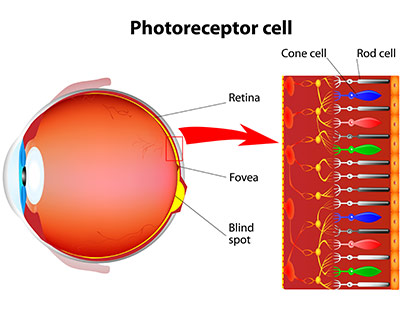
The retina is the back part of the eye that contains the cells that respond to light. These specialized cells are called photoreceptors. There are 2 types of photoreceptors in the retina: rods and cones.
The rods are most sensitive to light and dark changes, shape and movement and contain only one type of light-sensitive pigment. Rods are not good for color vision. In a dim room, however, we use mainly our rods, but we are “color blind.” Rods are more numerous than cones in the periphery of the retina. Next time you want to see a dim star at night, try to look at it with your peripheral vision and use your ROD VISION to see the dim star. There are about 120 million rods in the human retina.
The cones are not as sensitive to light as the rods. However, cones are most sensitive to one of three different colors (green, red or blue). Signals from the cones are sent to the brain which then translates these messages into the perception of color. Cones, however, work only in bright light. That’s why you cannot see color very well in dark places. So, the cones are used for color vision and are better suited for detecting fine details. There are about 6 million cones in the human retina. Some people cannot tell some colors from others – these people are “color blind.” Someone who is color blind does not have a particular type of cone in the retina or one type of cone may be weak. In the general population, about 8% of all males are color blind and about 0.5% of all females are color blind.
Picture Credit : Google

